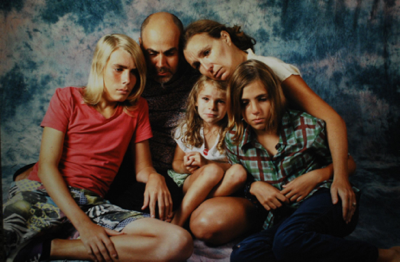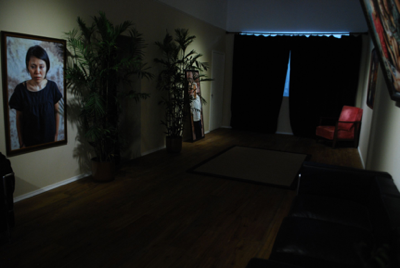

David Boyce and Adrian Wong, “ Affective Portraits: Gutierrez Family, 2011
The installation of our Affective Portraits, “ is reminiscent of shopping mall portrait studios where the faces are interchangeable,” says artist David Boyce. He is talking about the scenario he and artist Adrian Wong designed and orchestrated for the installation of their collaborative work, a set of photographs of uncommon images of emotion at OV Gallery on Moganshan Road in Shanghai, now the hub of the local art scene.
Their collaboration is seamless, with both artists distributing tasks equally, researching and developing their ideas, one with more background in photography, the other more in sculpture. Affective Portraits is a part of OV’s kick off the season show, I’ll Be Your Mirror; it’s title a reference to the Velvet Underground song. Amongst many other works by both local and international artists, their work really stands out as a significant achievement in conceptual thought. Boyce comes from a background of Social History studies, focusing on women’s rural history, while Wong has a background in Psychology, between them there is a richness to their insights and their conceptual threads that pervade their work, stemming from their educational experiences. Boyce describes himself as a photographer, while Wong says he is more of a sculptor.
At OV Gallery, the scene is set with couches and plants along with familiarly stylized portraits and backgrounds hung around an area of the gallery to create a room of its own through the arrangement. But wait, these are not your typical portrait studio productions, the generic backdrops and lighting are clever veils to images that are akin to nothing average, but rather the opposite, each person shows emotion, but in a posed production, a performance of sorts.
David Boyce and Adrian Wong discuss their process as a long effort of continual research and development using models who are participating on a voluntary basis, but who through the smallness of the Hong Kong art scene, are grouped as friends and acquaintances, while actually playing significant roles more often than not in the Hong Kong and world art scenes. One pair of artists and their family depicted in a photograph represented Hong Kong at the Venice Biennale several years back, while others could be curators or friends, culled from their mailing lists.
“My mother worked at a department store as a portrait photographer,” explains Wong, “I was surrounded by cookie cutter style photos. Visitors became subjects, devoid of emotional content.” He describes their installation as being “more immersive, more empathetic,” which is a kind of hold over from a larger exhibition of the past. There is something provocative about these portraits, with the common theme of the portrait studio, juxtaposed with affected facial expressions, the models coerced into tears or smiles through careful orchestration by Wong, using everything from onions to sound and light affects to stimulate emotion in the models. Boyce describes their friendship and collaboration as convivial, both of them having met at the end of 2006 by chance in the Hong Kong art scene. Both artists say that they have collaborated with other artists and each other, but this project is their largest one together so far.
It’s about, “ the ability to think in words…private speech impacts the quality of thought, my thesis was on covert and overt speech mapping, the internalization of children’s words,” says Wong, “ the portraits are about what could be potentially lost through this internalization, by giving language privacy as described by Jacques Lacan.” A French psychoanalyst, Lacan’s philosophy and research seems to reverberate in how Wong looks at our everyday experiences and ultimately, in how he approaches the conceptual in his art.
Wong explains that initially, humans are not able to think beyond an object, that thoughts beyond objects do not actually develop until after age two or three, this is the time when a child can look at his own reflection and identify it as him or herself. Additionally, Boyce emphasizes the, “ephemeral language of a portrait or a sculpture…language has such an overwhelming dictatorship of what we do.” Boyce describes himself as a conceptual artist and photographer, “I am too ADHD to draw or paint; I like the immediacy of a photo, or the perceived immediacy, what you don’t see is the research behind it before you get to the final work.” He talks about how being a visual artist; this space between language and thought is significant.
As a native of New Zealand, Boyce jokingly refers to American imperialism infiltrating his country in the past, but says that New Zealand culture is more like than unlike American culture, with the commonly seen portrait style photographs manifesting themselves, as everywhere else in the world, the only difference in the images and backdrops is physiological. An American from Chicago, Wong talks about the research, how they both were guinea pigs for his stimulus response tests, using onions, sound and lights to create emotional reactions in themselves in order to figure out how they would coax their models for the affected emotional response needed for the images.
“ There was a period of months where we were looking at catalogues, where you were schooling me in portrait photography,” Wong reminisces with Boyce about the prep work for the collaboration. “Ways of directing facial movement, ways of directing emotional states above and beyond methodology,” Wong explains as his role in the process to research and discover striving to “step outside behavior.” “I felt like a lot of the performance aspects were things I was focusing on,” explains Wong.

Affective Portraits Series Installation View at OV Gallery Shanghai
When asked specifically about their models, Boyce says, “ the people who worked the best in the situation were the people who had an understanding to what performance was about.” When asked about the clothing worn by the subjects, Boyce says that they had only the guidelines what to wear based on “standard guidelines, no bold stripes…fortunately, I think all of them wore what they would wear on a daily basis.”
This show is intriguing and even without the information about the process, one can see a rich layer of thought went into these works and that the portrait can be a record of a kind of theatrical presentation, which we all go through on a daily basis, even though we are unaware of it and that we are participating in some way in Affective Portraits.
I’ll Be Your Mirror at OV Gallery in Shanghai runs until September 11. I suggest you make some time to see it!
By Anne Murray

Leave a Reply